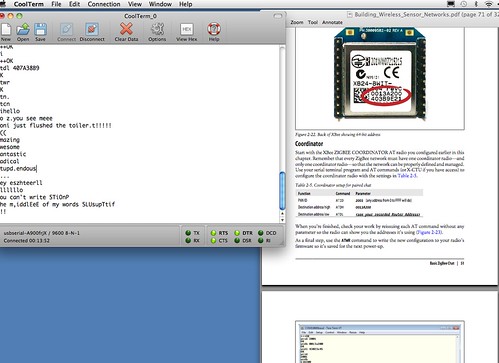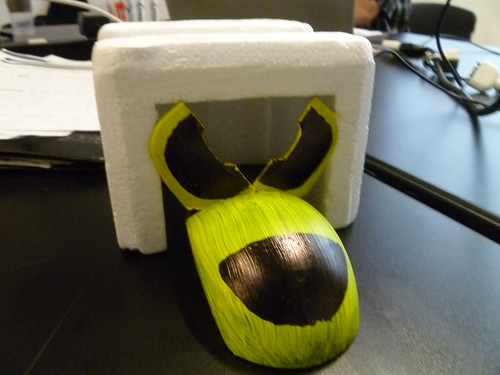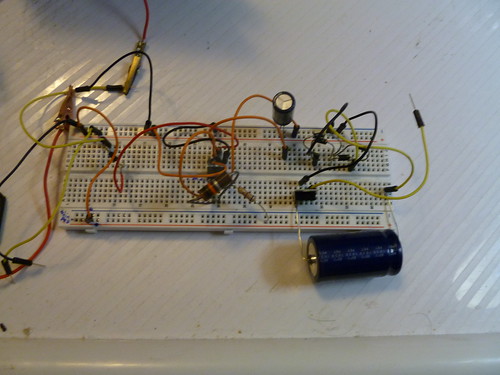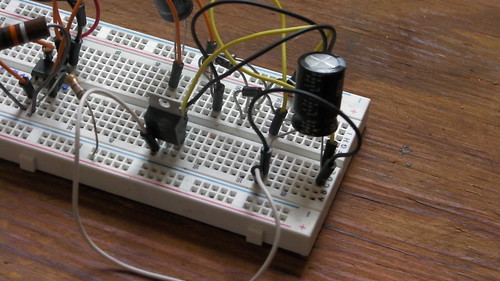For this week's lab we ran into a snag or two, but it was remedied. Apparently when following the instructions in the book, we still had XBee radios that had different AT commands that was mucking up our network. In the end we wiped all the XBees and followed the instructions again. This time it worked. Instead of using temperature sensors, we used photoresistors to get analog values. The processing sketched was remapped and became a "darkness meter". See video documentation below:
Sunday, October 30, 2011
Thursday, October 27, 2011
Friday, October 21, 2011
Variable DC Power Supply
Please see the full post on this Basic Analog Circuits project at Push The Other Button
Sunday, October 16, 2011
Recent Basic Analog Circuits Projects
I took the power supply lab for Eric Rosenthal's Basic Analog Circuits class to the Nth degree, building an enclosure and wiring in a volt meter for it. I documented the whole thing on the Makezine Blog.
I also have video below of my 555 timer circuit, and LM358 pre amp circuit.
'
I also have video below of my 555 timer circuit, and LM358 pre amp circuit.
'
Thursday, October 13, 2011
XBee Doorbell Lab
For Rob Faludi's Sensitive Buildings class, we were told to make a wireless doorbell using two XBee radios. Since my router and coordinator radios were already set up from the previous chat lab, I was expecting this assignment to be a plug-and-chug exercise (we were even given the code!) However, when the project didn't work I embarked on an epic troubleshooting journey. I tested everything from contact continuity, to swapping XBees, recalibrating them, an even doing the entire chat lab over again.
I had it narrowed down to an issue between the Router Xbee's serial communication with its attached Arduino. The indicator LED on pin six would light up when I pushed the coordinator's button, but the test LED for my "bell" coming from the digital pin on the Arduino refused to light up. I even ran a "hello world" sketch just to make sure the arduino was functioning properly with the LED. Oddly enough, once I pulled the indicator LED off pin six, the Arduino's LED started working! It was dumb luck that I discovered this, and as far as I know, my classmates did not have the same issue. I'm now wondering if this is a documented bug or not. I'm meeting Rob tomorrow and will update this post once we've taken a look at it.
UPDATE! Somehow the solder joint on the power pin of the XBee breakout board broke, but there was still a thin connection being made to the XBee. It was getting just enough current to either light the indicator LED, or send the serial communication to Arduino, but not both at the same time, which explains the strange problem I was getting. Once all the solder points were warmed up everything then worked like a charm.
I had it narrowed down to an issue between the Router Xbee's serial communication with its attached Arduino. The indicator LED on pin six would light up when I pushed the coordinator's button, but the test LED for my "bell" coming from the digital pin on the Arduino refused to light up. I even ran a "hello world" sketch just to make sure the arduino was functioning properly with the LED. Oddly enough, once I pulled the indicator LED off pin six, the Arduino's LED started working! It was dumb luck that I discovered this, and as far as I know, my classmates did not have the same issue. I'm now wondering if this is a documented bug or not. I'm meeting Rob tomorrow and will update this post once we've taken a look at it.
UPDATE! Somehow the solder joint on the power pin of the XBee breakout board broke, but there was still a thin connection being made to the XBee. It was getting just enough current to either light the indicator LED, or send the serial communication to Arduino, but not both at the same time, which explains the strange problem I was getting. Once all the solder points were warmed up everything then worked like a charm.
Saturday, October 1, 2011
Chatting with XBee
After setting up one XBee as a coordinator and one as a router using a PC, we hooked the Xbees to two separate Macbook Pros and went through the process of setting AT commands so they'd be able to talk to each other.
Using CoolTerm to do this was a blast from the past, as many of these commands were familiar to me from my days as a teenager dialing up and running BBSes. It's funny how the same technology is used all these years later.
The instructions in the text were clear enough for the most part, but it was a bit unclear as to how to set the XBee ID. It seemed that we were being told to set the ID of both units to the coordinator's ID, but it turned out we had to set a different ID for each unit instead. This was clarified in the "Troubleshooting" section later on.
Another problem was that after opening up communication with the "+++" command on the terminal program, it was difficult to refer to the instructions and type in the necessary commands before the terminal program reset itself and you had to type in "+++" again. A longer delay time definitely would have helped because we had to make several attempts during the setup due to this problem.
In the end we got it all to work perfectly, and here's the screenshot to prove it!

Using CoolTerm to do this was a blast from the past, as many of these commands were familiar to me from my days as a teenager dialing up and running BBSes. It's funny how the same technology is used all these years later.
The instructions in the text were clear enough for the most part, but it was a bit unclear as to how to set the XBee ID. It seemed that we were being told to set the ID of both units to the coordinator's ID, but it turned out we had to set a different ID for each unit instead. This was clarified in the "Troubleshooting" section later on.
Another problem was that after opening up communication with the "+++" command on the terminal program, it was difficult to refer to the instructions and type in the necessary commands before the terminal program reset itself and you had to type in "+++" again. A longer delay time definitely would have helped because we had to make several attempts during the setup due to this problem.
In the end we got it all to work perfectly, and here's the screenshot to prove it!

Labels:
colombo,
itp,
pushtheotherbutton,
Sensitive Buildings,
wireless,
xbee
Thursday, September 29, 2011
Sensitive Buildings: My Fantasy Building
I have an unabashed love affair with cars. So much so that the couple of jobs I've had as a driver were among my most enjoyable.
Driving a car so much, one learns to practically live in it. I had the notion once to build a car that was integrative into my house. I'd model it after Buckminster Fuller's aerodynamic Dymaxion Car.
I made a crude model to illustrate how this would be possible (can you tell what I made it from?)

The car backs into the driveway as the rear hatch irises and seamlessly integrates into the house's facade with the rear windshield now turning into a second story picture window. On the way home, the car remotely transmits it internal temperature and the house acclimatizes accordingly. No matter the outdoor weather conditions, I'm now able to simply walk from my car into my house without exposing my body to the elements.

The backseat of the car would be rear-facing, and now turn into a love seat facing the home entertainment center in the living room. Whatever I wanted to watch on TV could be done from here, and the car's own sound system can be utilized.
Driving a car so much, one learns to practically live in it. I had the notion once to build a car that was integrative into my house. I'd model it after Buckminster Fuller's aerodynamic Dymaxion Car.
I made a crude model to illustrate how this would be possible (can you tell what I made it from?)

The car backs into the driveway as the rear hatch irises and seamlessly integrates into the house's facade with the rear windshield now turning into a second story picture window. On the way home, the car remotely transmits it internal temperature and the house acclimatizes accordingly. No matter the outdoor weather conditions, I'm now able to simply walk from my car into my house without exposing my body to the elements.

The backseat of the car would be rear-facing, and now turn into a love seat facing the home entertainment center in the living room. Whatever I wanted to watch on TV could be done from here, and the car's own sound system can be utilized.
Labels:
buckminster,
cars,
colombo,
itp,
networks,
pushtheotherbutton,
Sensitive Buildings
Saturday, September 24, 2011
Modular Scrap Metal Percussion Instrument
This was my first assignment for NIME. Check out the full post at my main site, Push The Other Button.
Wednesday, March 16, 2011
Kinetic Energy Converter Project
I have a 3 year old cat named WiFi (pronounced Wee Fee) who seems to have an endless supply of energy. He loves to play, so I was motivated to help him harness his own muscle power in order to keep himself entertained. My idea was to create a device that would be attached to a cat toy on a string. When WiFi pulls the toy, a generator is turned, storing electricity in a capacitor and potential energy in a constant force spring. When he lets go of the toy, the string retracts, being pulled by the constant force spring, and even more electricity is stored in the capacitor.
The complete retraction of the toy flips a switch that activates a small fan attached to a 555 timer circuit. Using the electricity in the capacitor, the fan periodically blows onto the hanging cat toy, moving it, and motivating WiFi to start the process over again.
I started with an initial test using a tape measure. A standard tape measure has a constant force spring inside of it, and the 25 foot length was perfect for the open layout of my apartment.
Wifi seemed to be interested enough for me to continue work on this route. I hacked the tape measure and attached a spindle and pulley to it. Once mounted, I placed a small DC motor alongside, mounting that with a piece of hardware I had in my junk box.


The most time-consuming part of the fabrication was fine-tuning the motor and pulley so the belt would ride true and not slip off. There were lots of tiny adjustments of position, and I had to shim the motor into exactly the right place.

Once done, I knew that this could produce a viable amount of electricity, so I set to work on the circuitry. Since the motor would be spinning in both directions, I started with a bridge rectifier, this then went into the capacitor stage, followed by a 5V voltage regulator. After this was the 555 timer circuit. The 555 is a real nifty IC that I had never used before. Now that I know how it works I'm sure I'll implement it in future projects.
All components of the circuitry appeared to work except for the capacitor stage. I was told part of the problem was that I wired the capacitor in series rather than parallel, which turns the capacitor into a DC blocker. However, it still did not seem to work properly when I tried wiring it in parallel. This is something I'm going to have to continue to troubleshoot. This video shows the circuit working properly, but with a 9v battery in place of a capacitor
This photo shows the circuit with a capacitor wired in series.

This photo shows the circuit with what I believed was a proper parallel wiring.

If this gets worked out, I'd like to make a 2nd prototype using the spool from an auto-retracting AC power cord. The robust design and internal constant force spring makes this superior to the tape measure, not to mention the lack of sharp metal edges that the tape measure poses as a danger to both felines and humans.

The complete retraction of the toy flips a switch that activates a small fan attached to a 555 timer circuit. Using the electricity in the capacitor, the fan periodically blows onto the hanging cat toy, moving it, and motivating WiFi to start the process over again.
I started with an initial test using a tape measure. A standard tape measure has a constant force spring inside of it, and the 25 foot length was perfect for the open layout of my apartment.
Wifi seemed to be interested enough for me to continue work on this route. I hacked the tape measure and attached a spindle and pulley to it. Once mounted, I placed a small DC motor alongside, mounting that with a piece of hardware I had in my junk box.


The most time-consuming part of the fabrication was fine-tuning the motor and pulley so the belt would ride true and not slip off. There were lots of tiny adjustments of position, and I had to shim the motor into exactly the right place.

Once done, I knew that this could produce a viable amount of electricity, so I set to work on the circuitry. Since the motor would be spinning in both directions, I started with a bridge rectifier, this then went into the capacitor stage, followed by a 5V voltage regulator. After this was the 555 timer circuit. The 555 is a real nifty IC that I had never used before. Now that I know how it works I'm sure I'll implement it in future projects.
All components of the circuitry appeared to work except for the capacitor stage. I was told part of the problem was that I wired the capacitor in series rather than parallel, which turns the capacitor into a DC blocker. However, it still did not seem to work properly when I tried wiring it in parallel. This is something I'm going to have to continue to troubleshoot. This video shows the circuit working properly, but with a 9v battery in place of a capacitor
This photo shows the circuit with a capacitor wired in series.

This photo shows the circuit with what I believed was a proper parallel wiring.

If this gets worked out, I'd like to make a 2nd prototype using the spool from an auto-retracting AC power cord. The robust design and internal constant force spring makes this superior to the tape measure, not to mention the lack of sharp metal edges that the tape measure poses as a danger to both felines and humans.

Tuesday, February 15, 2011
Proposal for Sound and the City
Sunset Park has long been the home of working class immigrants in New York. Starting with a significant Norwegian, Finnish, Irish and Polish population who lived off the sweat of their brows in the 19th century, the neighborhood came to be a major worldwide shipping hub in subsequent years. Sunset Park’s Bush Terminal rose to become the center of international manufacturing and shipping in New York Harbor. By World War II, it was responsible for expediting 80% of American goods borne for foreign lands.
Later on when “white flight” affected large areas of New York City, Sunset Park was not immune. With this vacuum came falling property values and an influx of South American and Chinese inhabitants. The former came to live mainly between 4th and 5th avenues, and the latter between 7th and 8th. These two ethnic groups’ rise to prominence came in parallel, with very little cultural cross-pollination.
My audio installation aims to link these groups by creating a mutual, yet separate environment where human emotion, stripped of nearly all cultural trappings, can exist for a moment to be viewed by another.
I will post signs on telephone poles and shops in these neighborhoods and offer to pick up any appliances that utilize audio speakers as part of their function. Over several weeks I plan to collect several dozen speakers of differing size and type. As we know, speakers receive electrical impulses and translate them into mechanical motion. This motion sends out pressure waves through a medium, which our ears perceive as sound. Of course, the reverse can also happen. If pressure waves are received by speakers, they can be translated into small electrical impulses.
During a test, a 3 inch, 8 ohm speaker generated a maximum of 35 mV and 4 mA when screamed into. With many such speakers linked together in an array, enough electricity can be produced to light a small lightbulb.
The installation will consist of many speakers arranged circularly like the petals of a flower, with a nearly opaque plastic shield in the center, representing a pistil. An LED will backlight this shield, revealing a provocative written message when illuminated (perhaps simply “yes”, as an homage to Yoko Ono’s 1966 “Ceiling Painting”). Hidden behind the flower will be a camera that uploads video to an online network.
Near the flower will be a digital meter that tracks the voltage and amperage of the flower’s auditory input. A placard will instruct the user that they will receive a message once they “red line” the meter. The user will generate enough sound with his/her voice to receive the message, which will then be used as a password on a nearby computer terminal. The password will allow the user to view a video identical in format to the one they just created, but across the neighborhood where the other ethnic group resides.
There will be two of these stations in the aforementioned sub-neighborhoods of Sunset Park. The aim is to create inter-cultural connection through the innocence and universality of non-language-based vocalization.
Sunday, February 13, 2011
Final SoundWalk Mix
Done after some heavy EQ and extensive editing. I'm pretty happy with the results.
Final Soundwalk Iteration by PushTheOtherButton
Final Soundwalk Iteration by PushTheOtherButton
Wednesday, February 9, 2011
Sustainable Energy
This class is going to be fun. Can't wait to bring in all my gears and motors to class. I think for my presentation I'll be talking about energy storage using flywheels.
Tuesday, February 8, 2011
Revision to Sound Walk
This is the same recording as the previous post, but with my un-muffed signal deleted, leaving only the muffed signal. Enjoy!
Sunset Park Sound Walk Revision by PushTheOtherButton
Sunset Park Sound Walk Revision by PushTheOtherButton
Sunset Park Sound Walk
This is a walk through Sunset Park, where the local language and culture quickly changes from Spanish to Chinese.
Sunset Park Sound Walk by PushTheOtherButton
Google Map of the Soundwalk
Sunset Park Sound Walk by PushTheOtherButton
Google Map of the Soundwalk
Tuesday, February 1, 2011
Deep Listening Exercise #1
This soundcloud page contains all the materials from my first Deep Listening assignment for Sound and the City
Subscribe to:
Posts (Atom)



